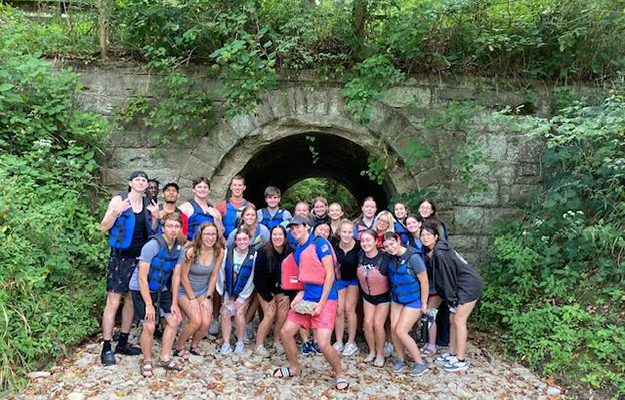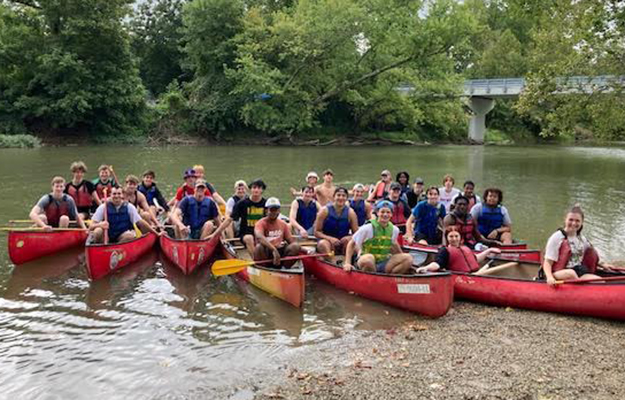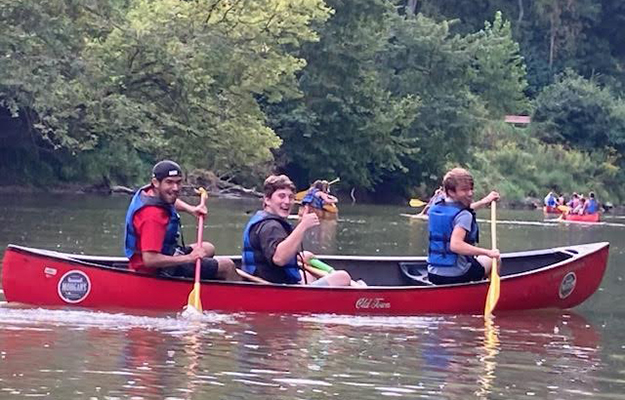Integrated Learning-Living Communities

Business Ethics & Environmental Sustainability: Fort Ancient/Hopewell Earthworks and Nature Preserve
A record number of new BEES (Business Ethics and Environmental Sustainability integrated living learning community) — 55 first-year students together with seven elders — participated in the maiden voyage, a canoe trip near the Fort Ancient (Hopewell) Earthworks and Nature Preserve in September 2023. The Fort Ancient complex just achieved the status as a UNESCO World Heritage site, the first in Ohio, and only the 25th site inscribed in the United States. The process of achieving this designation took 18 years, longer than some of the BEES’ lifetimes.
A special lecture by curator Pam Hunt revealed that the mounds and earthworks constituting the Fort Ancient site were built 1,600-2,000 years ago by the Hopewell people, who flourished in the east-central United States from 200-500 CE. She provided clarity for several sources of confusion.
- First, the very name —Fort Ancient— is a misnomer, because it was the Hopewell (Middle Woodland) people who constructed Fort Ancient (not the later Fort Ancient people who arrived in the Miami Valley around 1200 CE and briefly took up residence at Sunwatch, just across the Great Miami River from UD).
- Second, the assignation ‘Hopewell’ is derived from the farmer owning the land, not the people who constructed the earthworks.
- Finally, the label ‘fort’ is misleading because the site was never used for offense or defense, but for community gatherings. The earthworks can be better construed as a container for human activities, and its many openings speak to its role as a commons rather than an enclosure.

The last point speaks to the most important archeological evidence found on the site, from the standpoint of economists: evidence of trade across vast distances. Inputs — copper from Michigan, mica from the Carolinas, obsidian from Yellowstone, west of the Mississippi; and sea shells from the Gulf of Mexico were imported by the Hopewell in Ohio to craft delicate and highly prized eagle claw jewelry from copper and mica. The presence of expert artisans speaks to another key point. The hunter-gatherer lifestyle provided sufficient food surpluses to enable substantial specialization and division of labor and better health status (longer lives) as well.
Because some of those Middle Woodland peoples who devoted decades of labor to moving earth in Oregonia arrived by water, negotiating Ohio’s first scenic river, the Little Miami, the BEES replicated that approach and paddled wooden canoes down a three-mile stretch before exploring the earthwork’s museum, trying their hands at atlatl-throwing and partaking of a picnic reminiscent of more recent — arguably more invasive — arrivals: French bread and various cheese (brie, Boursin) to capture the first European invasion (French and British trappers and explorers), as well as apples, a nod to the efforts to nurseryman Johnny Appleseed to bring fruit/cider to the later American settlers and Dayton’s own killer brownies from Dorothy Lane Market.



